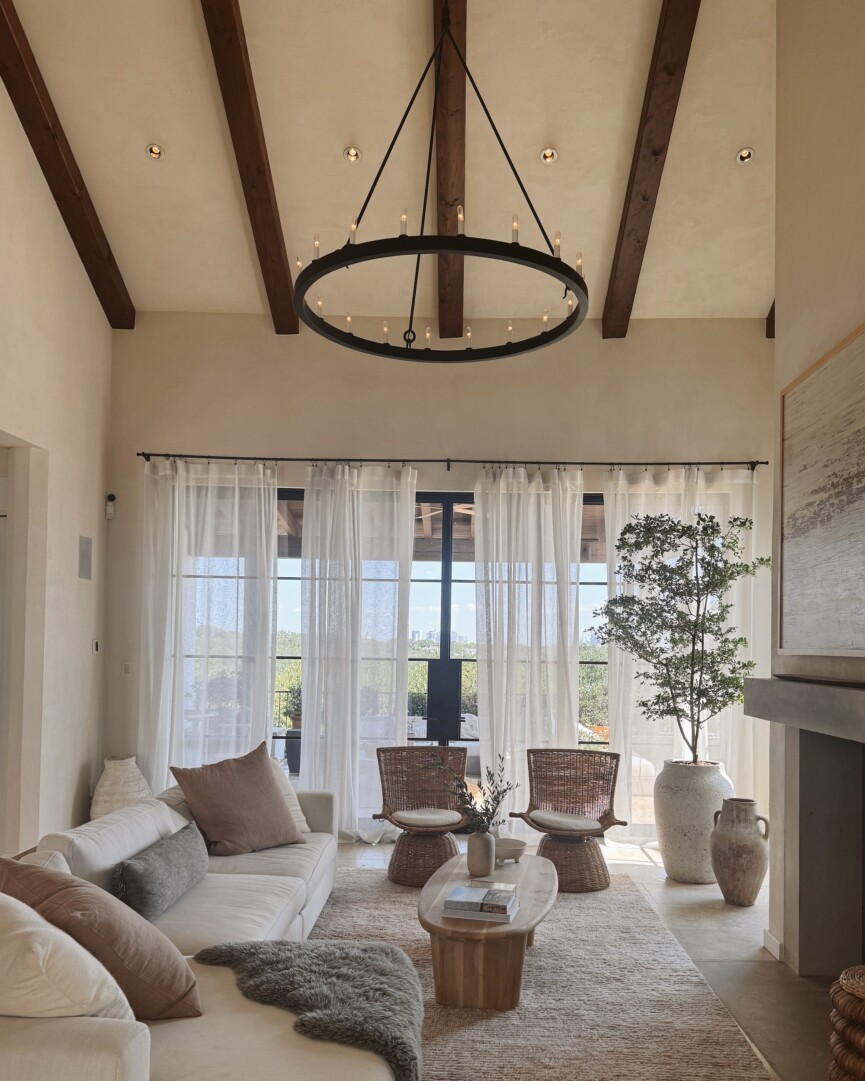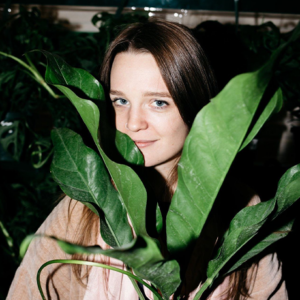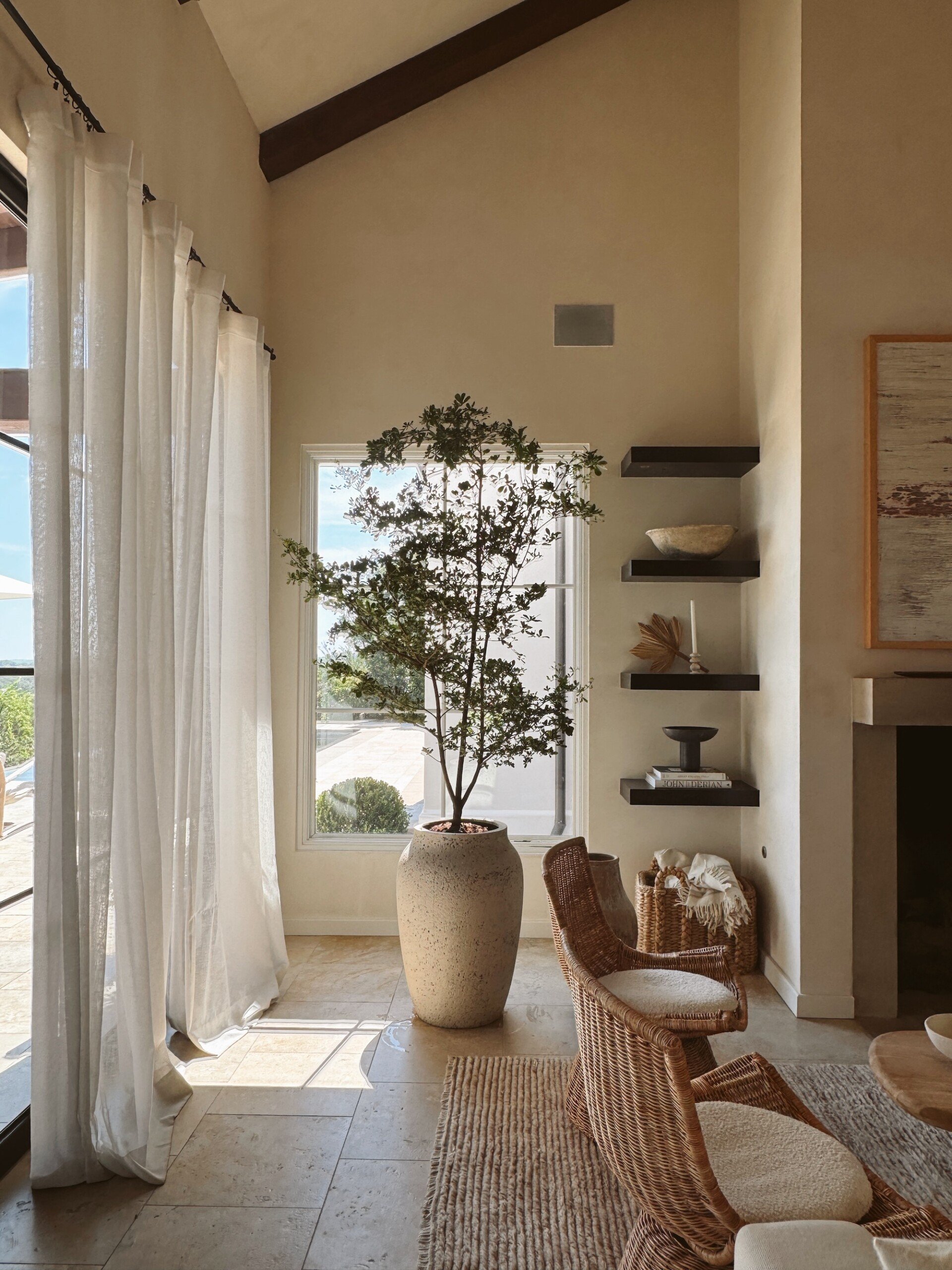One of my biggest life accomplishments is that I’ve kept my beloved fiddle leaf fig alive for six years now. This may seem silly, but if you know how finicky these plants are, you know this is not an easy feat. I remember seeing them all over my favorite home bloggers’ spaces and I pined for one of my own. They eventually got popular enough that they started to make regular appearances at Costco. My mom graciously scooped one up for me. Now the indoor house plant trend is slowly shifting. Instead of the fiddle leaf fig’s large and glorious leaves making a statement, designers are opting for a plant with a more delicate, understated beauty. And that plant is the black olive tree, otherwise known as the Shady Lady.

Everything to Know About the Black Olive Tree, aka “Shady Lady”
I chatted with Lily Cox, co-founder and CMO of Rewild to get the lowdown on all things Shady Lady. Rewild is a specialty house plant shop with multiple locations in the Washington DC area. Ready to learn about the design world’s new It-girl plant? Read on for everything you need to know!

What is the Shady Lady?
This plant goes by a few names—the black olive tree, the Shady Lady or its botanical name Bucida buceras. They are striking trees that contain an abundance of tiny leaves. Their delicate foliage have made them a recent favorite with designers, especially on the west coast. “This plant has been making the rounds for the past couple years now,” Cox shares. “If you’ve had other plants, especially other trees like a ficus or a fiddle leaf, then you’ll be able to manage a Shady Lady easily.”
When indoors, black olive trees can grow upwards of 15 feet. It’s best to give them a home with room to grow. These warm-weather plants are native to the Caribbean and South and Central America. They require lots of light and diligent watering. While some say the black olive tree is a high maintenance plant, Cox’s experience with the Shady Lady has been unexpectedly pleasant. “The team at Rewild has been resoundingly very surprised at how easy and straightforward of a plant it is,” she states.
How much light does a black olive tree need?
It’s very easy to fall in love with a plant simply based on aesthetics—especially the Shady Lady. I’ve brought home a few plants that quickly perished because I had no idea what kind of environment and care they needed. I just liked the way it looked. If you have your sights set on bringing a black olive tree into your home, you’ll need to be sure you have a spot that gets a lot of sun.
“They do like light,” Cox shares. “You don’t have to have them in an unobstructed south facing window exclusively, though they’ll be fine in the vicinity of a south, east, or west facing window.” Picking a spot in your home that gets consistent light throughout the day is best. You want to be sure you see the light touch the leaves of your black olive tree, and that the light hits as much of the foliage as possible. Leaves that don’t get enough light will begin to droop and eventually fall. As long as you have a sunny spot in your home, your black olive tree should thrive.
“They’ve done really well in our care. They’ve dropped very few leaves even, which surprised me, because they have so many tiny, beautiful little leaves on them,” Cox gushes. “They’re surprisingly well behaved.”
How often should I water a black olive tree?
Cox waters her Shady Lady about once a week and pays close attention to the black olive tree’s soil. “They like diligent watering,” she says. “We determine their need for water by sticking a finger straight in the soil at the base of the plant up to the first knuckle of your index finger. The top two inches need to feel dry. Then give it a good deep watering.”
If you’re not sure if the soil is dry enough, Cox recommends giving it a day or two. Check again and be sure there’s no moisture after 24 hours. Instead of keeping your black olive tree on a strict watering schedule, however, Cox recommends forming an interactive relationship with your plant. “I have a tendency to steer away from a prescriptive approach to plant care and more of a reactive approach to plant care. It makes your life so much easier,” she says.
The amount of water your black olive tree needs is dependent on how much light your plant is getting daily and how dry the air is in your home. She recommends finding a unique routine for you and your plant, simply by checking in on the soil and watering when it’s dry. “Having good drainage is really important though,” she notes. “Be sure there’s plenty of space for the water to exit the bottom of the pot once the contents of the pot have thoroughly saturated.”
Where can I get a black olive tree?
Even though this plant is quite popular, they’re not common in specialty plant stores just yet. Cox recommends looking at your local plant shops and asking shop owners if they can get their hands on one for you. “If your local plant shop has an established enough relationship with various growers, you can ask them to procure one for you,” she says. There are also faux options as well if your home doesn’t have adequate lighting.
How do I style the Shady Lady in my home?
The Shady Lady has been quietly popping up all over interior design print magazines and the like. While this year’s interior trends have been all about maximalism and bold design choices, the black olive tree is the most coveted indoor plant currently and is known for its delicate and demure features. If you’re looking to create a sense of calm in your home, or you’d like to add a touch of luxury to your space, the Shady Lady is an obvious indoor plant choice. “I think they work really well in homes with a European or a Mediterranean vibe,” Cox says. “Or even a west coast, specifically LA aesthetic.”
Adding a plant like a black olive tree to your home will breathe life into your space. The Shady Lady is tall, picturesque and would look stunning in a living room, an entryway, or even in a bedroom. It’s also worth noting that these trees don’t actually produce fruit. (No need to worry about plucking black olives!) As long as you have plenty of sunlight and are willing to water them as needed, the Shady Lady will be a fantastic addition to your home.

